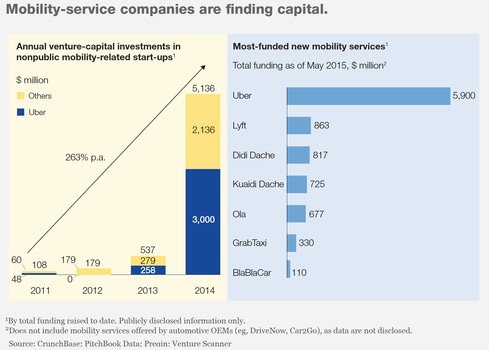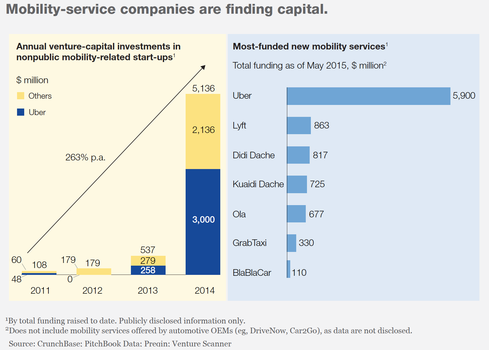Where Cars Fit In The Future
Cities are crowded, and in the years ahead, the transportation industry will have to adapt as more markets have less room for private cars.


New York Auto Show: Cool Cars With Hot Tech
New York Auto Show: Cool Cars With Hot Tech (Click image for larger view and slideshow.)
People around the world are moving from rural to urban areas. And if they prosper, as economic trends suggest they may, many in this emerging middle class will want cars.
But there's not enough room. Separate reports from consultancies Deloitte and McKinsey suggest mobility in urban areas will have to change to accommodate a population growth that makes traditional automotive ownership increasingly expensive and impractical.
Drivers in major cities know this already.
In San Francisco, where traffic congestion is said to be the second worst in the US, city policies and projects aim to get people out of personal cars. Selected street lanes have been painted red and restricted to buses and taxis. Bike lanes have been added. Streets are being torn up to accommodate the Central Subway, an underground transit extension. Construction continues on the new Transbay Terminal, which will accommodate high-speed rail.
In larger cities, driving, maintaining, and parking cars can be even less appealing, which is why car ownership in New York and Tokyo is so low.
The auto industry has been aware of the issue for years, though its attention has been piqued by the rise of ride-sharing companies and technological challenges from the likes of Google and Tesla.
Figure 1: 
(Image: McKinsey)
In 2012, Ford Motor executive chairman Bill Ford, Jr., talked about the need for technology to prevent global gridlock. That same year, BMW's venture group invested in Embark, a mobile app to simplify travel by mass transit, as part of its "vision for mobility in big cities." At CES 2015, Ford CEO Mark Fields described how Ford aims to be both a product and a mobility company, an acknowledgement that transportation may have to become a service rather than a purchased product in crowded urban areas.
Urban Issues
Stefan Knupfer, a director at McKinsey's sustainability practice and co-author of "Urban mobility at a tipping point," in a phone interview with InformationWeek said big cities have two major problems: traffic congestion and air pollution.
United Nations figures suggest that 7 million people die prematurely each year because of air pollution, partially as a consequence of transportation policy. The organization also projects that migration from the country to the city will add another 2.5 billion people to urban populations by 2050. Though close to 90% of this growth is expected to be concentrated in Africa and Asia, every urban area has to grapple with how mobility must change to accommodate population growth.
"The situation right now is that cities have to react," said Knupfer.
Is Innovation the Solution?
Knupfer sees four technological trends that can help: in-vehicle connectivity, electrification, car sharing, and autonomous driving.
In-vehicle connectivity will allow drivers to take advantage of real-time analysis of traffic data. That's already happening to some extent through mobile apps like Waze, which relies on crowdsourced traffic information. Waze is working with cities like Boston to share data with civic traffic control systems. But real-time traffic awareness will become more significant with the deployment vehicle-to-vehicle communications systems and related infrastructure. These systems will allow cars to drive closer together and to avoid collisions, among other benefits.
Electrification will bring electric vehicles into the mainstream. Market research firm IHS anticipates sales of electric vehicles and hybrids will rise from 2.3 million vehicles in 2014 to 11.5 million by 2022, reaching 11% of the global market. Developments like Tesla's Gigafactory should accelerate the trend by making batteries more affordable.
[The great electric car race is on: Apple Project Titan: Electric Car May Arrive by 2019.]
Car sharing will help cars spend less time idle while reducing the need for personal vehicle ownership. According to McKinsey, cars are unutilized 90% of the time or more. The firm projects that fully autonomous vehicles, such as those being tested by Google and other
Page 2: Gradual or rapid change?
companies, could reduce the cost of personal mobility by 30% to 60% relative to the cost of private car ownership.
Automation promises to allow cars that can navigate on their own, without a human driver. McKinsey suggests taking the wheel away from human drivers could reduce accidents by as much as 90%, saving thousands of lives and as much as $190 billion annually in the US by 2050.
Self-driving cars sound good in theory, but many practical impediments remain. Knupfer expressed some skepticism that fully autonomous cars will be accepted on public roads. "There is a liability issue and I think that's more the issue we see," he said. "A modern airplane can pretty much take off and fly by itself, but you still need a pilot."
There's also the chicken conundrum: Driving is often a game of chicken, in which drivers take conflicting action until one defers. When software it programmed to defer, human drivers and pedestrians can be expected to take advantage of easily cowed code. People will claim right of way at intersections because they can. Software doesn't know enough to bluff and it's doubtful the programmers of autonomous systems want to subject passengers or people on foot to a self-driving car capable of road rage.
Deloitte's study, "The Future Of Mobility," looks at the changing mobility landscape from the perspective of insiders – the established auto industry -- and disrupters -- the technology industry – and consider four futures in which mobility trends play out.
The first assumes only incremental change, in which private auto ownership remains the norm and automation technology appears mainly in the form of driver assistance. The second sees growth in car sharing, which reduces the need for vehicle ownership in urban settings. The third imagines strong uptake of autonomous vehicle technology in conjunction with continued private vehicle ownership. And the fourth foresees the convergence of autonomous and vehicle sharing trends to create a range of opportunities for mobility management companies.
The economic benefits of each of these possible futures remain unclear, but Deloitte projects a possible cost for vehicle owners in each, ranging from $0.97 per mile under the most conservative scenario (more or less the cost for a driver today) to $0.31 per mile in world that has fully embraced car sharing and vehicle automation.
Deloitte's study lists various forces that may delay or accelerate the transformation of mobility. Regulation and investment offer fairly straightforward paths to encourage changes, but the social and security obstacles could be formidable. There will be much more scrutiny of driver activity and many may not welcome having every in-car action monitored and measured. Data privacy concerns will have to be dealt with.
[Stop and ask for directions? No need soon, maybe. Read: Driving Toward Connected Cars.]
Automotive and technology companies may face pressure to submit to similar surveillance. Car cyber-security remains too insecure to leave unaudited. And Volkswagen's use of software to cheat on emissions tests has renewed the debate over the place of proprietary code in devices that affect public health and safety.
Between the two studies, it's clear that transportation faces a monumental shift. What's less evident is the extent to which the shift will be manual or automatic. Chances are we'll see something in between.
About the Author(s)
You May Also Like
How to Amplify DevOps with DevSecOps
May 22, 2024Generative AI: Use Cases and Risks in 2024
May 29, 2024Smart Service Management
June 4, 2024







